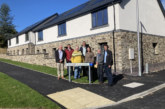
Mitsubishi Electric and SNG (Sovereign Network Group) have joined forces to deliver a pioneering retrofit programme that has the opportunity to transform the social housing renewable heating landscape in the UK. By leveraging Mitsubishi Electric’s Ecodan R290 high-temperature air source heat pumps in homes with existing microbore/small bore pipework, the initiative cuts costs, reduces disruption, and could accelerate decarbonisation across SNG’s housing portfolio.
SNG, which manages more than 84,000 homes for 210,000 customers across London and southern England, is piloting the use of high-temperature Ecodan heat pumps which work effectively and efficiently with legacy microbore/small bore systems — narrow pipework once thought incompatible with heat pump technology. This innovative approach, backed by Mitsubishi Electric and SNG’s extensive research and paper on microbore/small bore compatibility, removes one of the biggest barriers to large-scale heat pump retrofitting in older homes.
Jim Dyer, Built Environment Director at SNG, explained: “This solution emerged from our desire to innovate and balance key priorities for both our customers and SNG: minimising disruption, cutting fuel bills, avoiding early replacement of components, and reducing both installation cost and the ongoing maintenance costs. It’s an ambitious holistic approach that places our customers’ wellbeing and operational cost-effectiveness at its core.”
The benefits of this retrofit strategy are far-reaching:
- Reduced disruption to residents by avoiding the need to replace radiators and pipework or remove and replace floor coverings
- Significant capital savings by retaining existing pipework and radiators
- Improved energy efficiency and fuel bill reduction — crucial for tackling fuel poverty
- Lower operational and long-term maintenance costs
- Faster installation timelines, with SNG’s trusted contractor reporting installations completed in as little as two days
 The project builds on the strengths of Mitsubishi Electric’s R290 Ecodan system, which offers up to 300% efficiency, reliable performance in sub-zero temperatures, and the use of a natural refrigerant with a global warming potential of just 0.02. It is an ideal match for both retrofit and new-build social housing.
The project builds on the strengths of Mitsubishi Electric’s R290 Ecodan system, which offers up to 300% efficiency, reliable performance in sub-zero temperatures, and the use of a natural refrigerant with a global warming potential of just 0.02. It is an ideal match for both retrofit and new-build social housing.
By retaining the radiators and microbore/small bore infrastructure (plastic and copper pipework), the direct replacement of gas heating with a heat pump is possible. Mitsubishi’s Electric R290’s Ecodan system is the key enabler in this approach.
James Chaplen, Mitsubishi Electric Head of Product Marketing and Communications said: “The ability to retain microbore/small bore pipework of all types is a game-changer for retrofit projects. With our Ecodan heat pumps working effectively with existing systems, we’re removing a major financial and logistical hurdle. This opens the door for housing providers like SNG to scale-up their net zero efforts without compromising on resident comfort or driving up costs.”
The partnership reflects a priority in the housing sector for smart, scalable, and resident-friendly solutions to decarbonise UK homes. With a firm commitment to achieving net zero by 2050, this programme demonstrates how innovation, when paired with local insight, can drive real change — now.
 Mitsubishi Electric and Sovereign Network Group have launched a new report exploring the deployment of heat pumps in heat pumps in social housing. It’s found:
Mitsubishi Electric and Sovereign Network Group have launched a new report exploring the deployment of heat pumps in heat pumps in social housing. It’s found:
- Heat pumps can provide significant cost savings — with one SNG resident saving around £700 per year on energy bills
- Heat pumps can be installed in as little as two days — 40% quicker than the average installation time
- Contrary to what homeowners think, they don’t require a complete retrofit — and can be installed alongside existing radiators and pipework
The full report can be found online here









